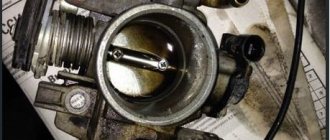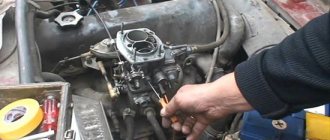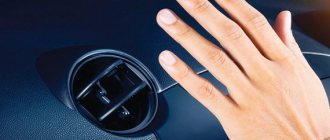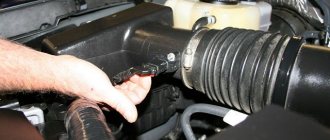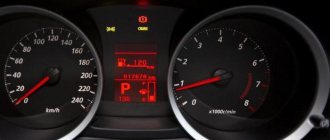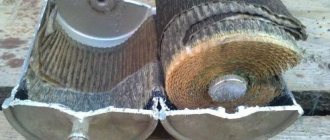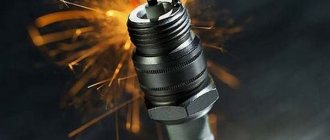There can be many reasons why a car stalls while driving. This could be a malfunction of the fuel system, or problems with the engine or ignition system. Many reasons for engine stalling are possible only on a carburetor system, and some are only possible on an injection system. The nature of the engine's operation at the moment before stopping can suggest the direction of troubleshooting. Often, after stopping, it is possible to restart the engine and continue driving. This behavior should also be involved in the logic of searching for the problem of why the car stalled. It should be noted that an injection car has more reasons for sudden breakdowns.
Sudden engine stop
If the engine was running normally while the car was moving, and suddenly the car stalled, then the following may have happened:
- clogged carburetor jets;
- fuel pump failure;
- broken timing belt;
- malfunction of the crankshaft position sensor;
- malfunction of the idle speed controller;
- malfunction of the ignition distribution system.
Looking for reasons
All of the above reasons, with the exception of a breakdown of the crankshaft sensor, can be determined independently in a minimum of time. First of all, you need to understand whether the combustible mixture enters the combustion chambers of the engine. To do this, you need to unscrew and examine the spark plugs. If the spark plugs are dry, then the cause is most likely in the fuel system. In a carbureted car, the cause most often lies in the carburetor. There are many reasons, ranging from clogged fuel jets to lack of fuel in the float chamber. The fuel level in the float chamber is controlled by a needle valve connected to the float. The float may cling to the chamber body and not open the valve.
Clogging of the needle valve or jets can be caused by the ingress of foreign unfiltered particles or tar deposits as a result of using low-quality fuel. Resins are washed off using aerosol cans with carburetor cleaner, and blockages are washed off with a stream of air from the compressor.
Cleaning the nozzle holes with metal wire is strictly prohibited. The burrs left by the wire will lead to changes in the characteristics of the jets and will require their replacement and subsequent carburetor adjustment.
Wet spark plugs indicate that the engine has a working fuel system.
You should immediately check the ignition system for the presence of a spark. If all the spark plugs have traces of fuel and a spark, then conclusions can be drawn about the serviceability of the ignition and fuel supply systems. It is worth warning that the malfunction of a single spark plug or spark plug wire cannot lead to the engine stopping. This happens if the ignition distributor - distributor, module or ignition coil - fails.
The camshaft drive belt can be viewed by removing its cover. On many cars, a broken timing belt is accompanied by a strong blow when stopping. This occurs as a result of uncoordinated movement of the valves and piston and their mutual impacts. The pistons do not have grooves, which is why they collide with the valves. On such engines, special attention should be paid regularly to checking the condition of the belt. Some engines have grooves on the pistons, so a break in the timing belt goes completely unnoticed for them.
The collector shaft position sensor can only be checked by installing a new one on the car. None of the engine sensors will cause the engine to stop anymore, since the on-board controller has several backup operating algorithms and will ensure engine operation, albeit with increased fuel consumption and reduced power. At first, you can continue driving with such breakdowns.
The operation of the electric fuel pump of injection cars is checked by the presence of fuel in the fuel rail.
Why does the engine start and stall when cold?
There are only three global reasons why a cold engine starts and immediately stalls:
- the engine does not receive enough fuel;
- incorrect operation of the air generation and supply system;
- problems with the exhaust system.
Main reasons
In turn, the causes of the breakdowns listed above can be various engine parts, including the fuel and exhaust systems.
- Air leak .
Because of this, a lean air-fuel mixture can form, which naturally leads to a decrease in power, including the fact that the car stalls when starting off on a cold engine. Air leaks can occur in different places - on air hoses (mains), fastening points (clamps), through a dirty throttle valve (its loose fit), as well as for other reasons. Air leakage is also possible through the idle air valve . On most cars it is driven by a stepper motor. If the engine malfunctions or if the valve is dirty, air will pass through it, and accordingly, a lean air-fuel mixture will form. And if the car works while accelerating, it may simply stall at idle a few seconds after starting the engine. - Injectors do not hold fuel . In some cases, after turning off the engine, the injector/injectors do not hold fuel and it simply flows out of them. Then, the next time the engine is started, there is a lack of fuel and the engine stalls when cold.
- Fuel pressure control . In diesel engines, when the temperature drops, this unit may not work well, including due to the fact that thick (summer) diesel fuel is used. Accordingly, as the fuel warms up, the operation of the regulator improves. As for gasoline engines, their fuel pressure in the system simply drops.
- Use of low-quality fuel . If there are a lot of harmful impurities in the fuel, then during the combustion of the air-fuel mixture, not much heat is generated, and accordingly, the engine does not develop the required power. This also happens when the engine is started cold, when the engine has not warmed up, and it needs more heat for normal operation in the future.
- Throttle position sensor (TPS) . When transmitting incorrect information about the throttle position to the control unit, the ECU may give commands to create a lean fuel mixture, which will naturally lead to the fact that a few seconds after starting a cold engine, it will simply stall in the cold.
- Mass air flow sensor (MAF) . Here, similarly, if the data from the sensor is incorrect, a lean air-fuel mixture may form, which in the cold will lead to a quick stop of the engine after starting.
- Faulty coolant temperature sensor . If it does not work correctly, it transmits information to the electronic control unit that the engine is warm enough, and accordingly, a lean mixture is needed for its operation. In fact, when the engine warms up, a rich air-fuel mixture is needed. Because of this, after starting, a situation is possible where the engine idles and stalls when cold.
- Faulty idle air control . When the engine is cold, this device gives the controller information that it is necessary to make increased speed when cold in order to warm up the engine faster. If the idle speed controller (IAC, also called the idle speed sensor) is faulty, then this may cause the engine to not increase in speed, and the cold engine will simply “choke” and stall almost immediately after starting it.
More rare reasons why the engine stalls during a cold start
The malfunctions listed above are the most common reasons why a cold engine stalls at idle. However, there are a number of additional reasons, including those characteristic of carburetor and diesel engines.
- Thick motor oil . In winter, engine oil thickens as the temperature drops, making it more difficult for the engine to turn the shaft in thick lubricant conditions. Therefore, in some cases it happens that after starting the engine, if the driver does not apply gas until the oil becomes more liquid, there is a possibility that the engine will stall.
- Problems with spark plugs . If the spark plugs wear out significantly when cold, they may not produce a good spark, and accordingly, misfires may occur, followed by engine shutdown.
- Fuel pump relay . Some car owners note that in cars with injection gasoline engines, the fuel pump relay in the fuel tank may “glitch” in the cold. This is usually due to damage to its contacts or other internal elements.
- Faulty turbocharger . This can cause problems with exhaust gas recirculation.
- The catalyst is not working properly . You can check the catalyst yourself in a garage. Sometimes moisture gets into it, and in the cold it crystallizes and prevents it from working normally, which is why the exhaust system suffers, and when starting on a cold engine, the engine stalls literally a few seconds after starting. However, this is a very unlikely cause, since it would take a lot of water to paralyze the catalyst in this way.
- Water in the muffler . Moreover, it can be there both in liquid and solid state (ice). In any case, this will cause the car to stall when starting a cold engine. In turn, moisture can get into the muffler for three reasons - the condensation process due to temperature changes, the ingress of antifreeze or antifreeze into the cylinders (for example, when the cylinder head gasket is broken), or due to the use of low-quality gasoline (with a high moisture content).
- No vacuum . There may be no vacuum in the carburetor itself, in the intake manifold, or in the vacuum hoses. When starting the engine “cold,” this is especially true, since the pressure in the system is balanced, and as a result, an air-fuel mixture with optimal parameters cannot be formed, which leads to the engine quickly stalling after starting.
Problems of injection engines
Sometimes the car stalls while driving during sudden acceleration on fuel-injected cars with a small amount of fuel in the gas tank. Why does this happen? Because the tank in such cars is located horizontally, and even 10 liters of gasoline form a thin layer. During sharp acceleration, especially on an uphill slope, the fuel is pressed to the rear wall of the gas tank, the gas pump picks up air, and the car stops. Since fuel consumption is at its maximum during acceleration, the pressure in the fuel rail drops almost instantly and the engine stops. After stopping the car, the engine starts without problems.
Fuel pump
If the fuel pump does not work, then, of course, the car stalls. The carburetor will work perfectly, but no one gives it gas. On fuel-injected cars, the fuel pump is located under the rear seat. On carburetor engines - near the camshaft (since it is driven by it). If it stops working, the engine may idle normally, but when the speed increases, it will definitely stall. However, if the gasoline pump is completely worn out, the engine will not start at all. To get rid of this malfunction, it is necessary to either repair the pump or replace it completely, which is the most effective. As for carburetor engines, the pump diaphragm drive rod can wear out greatly.
Checking the fuel pump relay
Much more often the fuel pump relay breaks down. To check it, you need to turn the ignition switch with the engine off. A click should be heard in the area of the relay, and within a few seconds the fuel pump will start operating. If there is a click, but the pump does not work, the contacts in the relay may be burnt. This can be checked with an ohmmeter with the relay de-energized and after applying 12 V voltage to its winding from the battery terminals. Open contacts should show infinity, and closed contacts should show resistance in fractions of an ohm. If the relay is working properly, you need to check the ground connection to the fuel pump.
Idle air control malfunction
A malfunction of the idle air control when the vehicle is moving stops the engine when the gas pedal is released and the throttle is closed.
You can check the regulator by removing it from the fuel system. A working regulator should show a resistance between the terminals of about 20–80 Ohms. When connecting the terminal with the ignition on, the regulator rod should make some movement.
For the first time, in order to drive the car to the service station without outside help, you need to remove the terminals from the regulator and manually, through several attempts, find such a position of the rod when the engine idles steadily so that the car does not stall when releasing the gas.
Intermittent operation
Stopping the engine is often preceded by interruptions in normal operation. If the fuel pump fails or the remaining fuel in the fuel tank runs out before stalling, the engine begins to jerk because the fuel pump picks up air along with the remaining fuel. A clogged fuel filter can manifest itself in different ways. At idle or while driving at low speed, the engine operates normally, but when accelerating or under heavy load, the filter’s throughput is no longer enough, and a lean mixture enters the cylinders, causing the car to stall while driving. To check the flow of fuel in injection engines, it is necessary to measure the pressure in the fuel rail. It should not be less than the set value for a given engine type.
A clogged air filter also affects operation in the same way.
An incorrectly adjusted carburetor produces an over-rich mixture, which can result in flooding of the spark plugs, causing them to fail.
As a result of incorrect valve adjustment, filling with low-quality gasoline or with an unacceptable octane number, burnout of the valves may occur. Usually the valves in one of the cylinders burn out. The engine starts to stall, suddenly loses power and may stall. Burnout of valves in two or more cylinders causes an immediate engine stop. This malfunction is checked using a compression meter in each cylinder. A reduced compression value will tell you which cylinder has failed.
A modern car is equipped with a catalytic converter for exhaust gases. If the converter is destroyed, the exhaust gases cannot leave the combustion chamber, which will also lead to a shutdown. You can check the catalyst only by removing it from the exhaust system.
Air filter
The situation is similar as in the case of a gasoline filter element. Please note that the operation and repair of the vehicle must be carried out in accordance with the manufacturer's requirements. After all, you know that a mixture of gasoline and air is supplied to the combustion chamber. Consequently, if any component of this mixture does not enter the fuel rail, the engine will stall. Consider an example of how a motor operates when there is not enough air. Too rich a mixture enters the combustion chamber, causing the spark plugs to flood. At the same time, there is a feeling as if the engine does not have enough air, it is suffocating. Among other things, some motorists who do not know about the principle of operation of an internal combustion engine can cover the inlet pipe with a rag to prevent water from getting into it. It's funny, but this happens.
Summary
As you can see, there can be many reasons why the engine stops while driving. The driver, like a doctor, must take into account and analyze all the “symptoms” in order to establish an accurate “diagnosis” of the car. If the diagnosis is unclear and there is not enough repair experience, you should contact specialists at a service station.
Car owners often find themselves in a situation where the engine suddenly stalls, whether the car is driving or idling. From this article you will learn about the reasons for engine stopping, diagnostic methods, and repair methods.
How the engine and fuel system work
To understand such strange behavior of a vehicle, you need to understand how its engine functions. Regardless of the type of fuel, the operating principle of the power unit is always the same - the air-fuel mixture flares up in the cylinders, creating high pressure due to the release of combustion products. This increased pressure pushes the piston towards the crankshaft, causing the latter to turn in the desired direction. The consistent operation of all cylinders, as well as the heavy weight of the crankshaft and flywheel, ensure smooth engine operation. We discussed these issues in more detail here (the car stalls at idle and at low speeds).
Reasons for stopping the engine at idle
Car owners and service station workers agree that the reasons for engine stalling can be:
- malfunction of the idle speed sensor, or its partial malfunction;
- malfunction of the throttle position sensor;
- presence of blockage in the throttle valve;
- clogging of the carburetor or injector (depending on the type of car).
It happens that the problem may be low quality fuel or its absence in the tank, as well as other malfunctions. If the breakdown is more serious than it seems, then it is better to contact a service station.
Carburetor engine
Carburetor is a component of the internal combustion engine power system designed to mix flammable liquid with air and supply it to the engine cylinders. The operating principle of such an engine is that the fuel, compressed in the combustion chamber, is ignited by an electric spark. Based on the number of cyclic cycles, carburetors are divided into four-stroke, two-stroke and four-stroke with a half-turn of the crankshaft. In carburetor engines, problems with idle stop occur mainly due to mechanical failure or simple contamination of engine parts.
What to do if the car stalls at idle
Hose between manifold and VUT
First of all, you need to check the hose going to the vacuum brake booster and its valve. To do this, you need to remove the hose and try to blow it out with your mouth. If the air flows in one direction and not in the other, then everything is fine. It is also worth checking the vacuum brake booster and its membrane. If they fail, they are replaced.
Make sure the throttle body and air filter are clean. To change a dirty filter, you can first try to shake it out and see the result immediately; if the car stalls when stopping at traffic lights due to lack of air, then the situation will improve a little. And to check the operation of the damper, you will have to remove the throttle assembly and see how it fits. Over time, it becomes covered with a thick layer of soot. Cleaning should help in this case.
So it’s worth removing and inspecting the level of contamination of the idle air regulator. It often happens that it leaves a gap for air, or simply gets stuck in one position due to wear somewhere in the middle. If so, then try cleaning it.
To check the crankcase ventilation valve, you need to remove the ventilation hose and check the valve on the cover. It simply becomes clogged with oil deposits. Regular cleaning often helps.
Remove and check the distributor. You need to check the contact group, the gaps between the contacts, the insulation of the wires, the condition of the terminals, and whether there is moisture inside. On carburetor cars, you also need to check the carburetor settings so that it maintains idle speed, as well as its general condition. In particular, cameras and float. If the carburetor is dirty, clean it with carb cleaner.
On a fuel-injected car, it is advisable to dismantle and check the performance of the injectors. If they are simply clogged, then they need to be cleaned. And to determine which sensor is faulty, you first need to check for errors in the ECU memory using an electronic scanner. If there are errors, then you need to look at their decoding, which may indicate a faulty sensor. Well, each sensor has its own verification algorithm.
Diagnostic sequence
There are no exact recommendations for the diagnostic sequence. If the engine stalls periodically, it is better to wait a little time and try to find out what the problem is. It is not difficult to determine a malfunction in the operation of an internal combustion engine - electronic diagnostic systems allow the electronic control unit to record problems. Verification methods based on visual and auditory observations should be kept in mind. The presence of extraneous noise, changes in the color of gas exhaust and other signs indicate a malfunction of the engine. Car owners with extensive driving experience know that minor faults lead to big problems - major engine repairs or complete replacement. Periodic inspections of parts and components of the unit, which are recommended to be carried out once a week, help to avoid such problems:
- check the level of engine oil and antifreeze;
- inspect for damage and ruptures of tips, connectors, hoses;
- monitor the operation of gaskets and seals.
Common problems on all engines at idle
As the old saying goes, a motor won't run if there's nothing to ignite, or nothing to ignite.
For gasoline engines with quantitative control of the mode, the idle conditions are the most severe. The throttle valve is closed. The volume of air entering the cylinder is minimal, and so is the pressure - just enough fuel mixture is supplied to allow the engine to rotate.
The oscillogram of the pressure in the cylinder, even at slightly increased speeds, gives us a pressure peak slightly above 5 bar. And this, mind you, is a serviceable engine, whose compression when hot is 13 bar. Now imagine what the pressure will be when it’s cold, when the pressure loss through the piston rings is greater. Therefore, since ancient times, almost the first thing people look at when a car stalls at idle is the condition of the engine. Measuring compression, even with a crude mechanical pressure gauge, accurately determines how worn the cylinder-piston group or valves are. In highly accelerated engines, wear is also added to by the possibility of errors when setting the marks of the gas distribution mechanism. Where the GAZ-69 works quietly when the camshaft gear is shifted by a tooth, a more modern engine is no longer able to hold idle.
Excessive pressure losses in a worn-out engine during the compression stroke can only be compensated by increasing the air supply. You have to maintain the speed with the gas pedal, but starting the engine will be a whole ritual, since at starting speed the peak compression pressure is even lower than at idle.
For a diesel engine, compression is even more important. By heating the air, which is compressed in the cylinder, the fuel injected by the injector is ignited. At the same time, the regulation of the regime in diesel engines is qualitative, not quantitative: as much air enters the cylinder as it can draw in, only the volume of injected fuel changes. But due to the fact that at idle the compression stroke time is the greatest, with loss of tightness (wear of rings, burnout of valves, losses through the cylinder head gasket), the highest loss of compression pressure will be at idle, and a diesel engine operating normally at high speeds, when released The gas pedal may also start to stall.
We must not forget about the quality of the fuel itself: it often happens that problems begin after refueling. Moreover, the emergence of network gas stations did not reduce the scale of the problems; rather, on the contrary: if previously it was possible to protect yourself from an outright “leftist” without stopping at openly suspicious gas stations (for example, in his own city, the author quickly learned where to refuel, where not, and where – only if it is urgently needed), but now gas stations of large chain companies regularly supply car repair shops with cars that stubbornly refuse to work: it is enough to mistakenly splash diesel fuel into the gas tank instead of the “ninety-two”, and even the unpretentious UAZ-469 will begin to work intermittently.
Problems with carburetor engines
The idle system in the carburetor is the most sensitive to contamination. Therefore, if a carburetor engine stalls at idle, it is worth blowing out the jets and channels of the idle system, and on cars with electronic forced idle control, also check the operation of the economizer solenoid valve. On Solex carburetors (VAZ 2108-2109), the idle fuel nozzle is mounted on the solenoid valve rod, and if there is no voltage on the valve, it is closed. To make sure that the valve is at fault, on these carburetors it is enough to unscrew it slightly to remove the pressure of the jet against the body and allow fuel to flow past the blocked jet. Has the idle speed stabilized? This means that either the EPHH unit does not supply voltage to the valve (which is checked with a light bulb or a tester), or the valve itself is inoperative.
There are not many reasons why a valve control unit may not supply voltage to it. In addition to the malfunction of the unit itself, this is a loss of power at pin 4, a broken connection with the ignition coil (the EPHH unit stops “seeing” engine speed), and the absence of “ground” at the carburetor end (pin 5) when the gas pedal is released.
This is interesting: Two simple ways to replace power steering fluid for all cars
Note that a common problem with carburetors is the rigid connection between the composition of the air-fuel mixture from the vacuum and the fuel level in the float chamber. If any of these parameters change, the composition of the mixture will also “float away”. It will go beyond the limits of normal ignition - if the car does not idle until it warms up, then the mixture is over-lean, but if the car stalls when hot, then over-richness is already occurring.
A change in vacuum at idle is a consequence of air leaks through the vacuum lines (for a VAZ, this is often a vacuum brake booster or a vacuum distributor corrector) or a violation of the tightness of the joint between the carburetor and the manifold. Here, Solexes have a long-known disease with warping of the mating plane of the body; Ozones show themselves better in this regard.
The ignition on carburetor cars in the vast majority of cases is distributor-type, with the exception of two-cylinder engines, where it is enough to use a two-terminal coil without spark distribution. If the motor stalls and does not start, then the problem is hidden until the spark is emitted - look at the breaker contacts, the central high-voltage wire, the carbon contact connecting the cover and the slider.
Problems with spark plugs are common to both carburetor and injection engines. This includes natural wear, which under normal conditions proceeds evenly; sooner or later all the spark plugs in the set will begin to work intermittently, and carbon deposits due to low-quality fuel or a violation of the mixture composition (over-enrichment, carbon black carbon deposits damage the spark plugs). Iron-containing additives (the notorious ferrocene) can “kill” spark plugs in one unsuccessful refill. So you should immediately pay attention to the candles, especially if access to them is not difficult.
Ignition system
Pay attention to the condition of the ignition module (article on module repair here), high-voltage wires and spark plugs. If there are traces of corrosion, melting on their surface, or there are cracks on the body, this will only mean that each of the above elements will require replacement, since they cannot be repaired or corrected. In order to correctly approach the issue of choosing spark plugs for the VAZ-2112, you can read this article.
First we check the wires, and then the spark plugs.
Supply system
In this case, check all the wires coming from the battery, generator and ECU. Since even the slightest short to ground of the power wires can shut down the engine.
Malfunction of the mass air flow sensor
Malfunctions of the mass air flow sensor or its incorrect operation very often lead to the engine stalling at idle speed. To eliminate this reason, it is enough to replace it.
Why does the injector stall at idle?
The advantage of VAZ injection systems, which were first installed on the 2110 family, and then on the subsequent G8, slightly updated in appearance 2114-2115, is that they are simple in design, and as a general example of injection system malfunctions are the most obvious.
The injection ECU has feedback algorithms and influences the idle speed both grossly (using the idle speed controller or “electronic” throttle) and subtly (by varying the ignition timing), so it is more difficult to make the injection engine stall. In addition, the abandonment of the distributor and the installation of either a dual ignition module (eight-valve models) or individual coils (sixteen-valve engines) also increased the reliability of the ignition system: at least on two cylinders, the engine will work. Air leaks have also become less critical. The revolutions will begin to fluctuate, but if the idle speeds disappear, then the reason is hidden elsewhere.
Here, one of the most likely culprits is significant contamination of the injectors. Four-nozzle injectors of eight-valve engines are sensitive to dirt: their flow area is the same as that of two-nozzle injectors of 16-valve engines: the area of each individual hole is half the size, and it is easier to clog it. There are cases worthy of jokes: on an excessively clogged fuel filter, the pressure developed by the fuel pump is enough to tear the filter curtain, and the flow of fuel will carry the accumulated dirt into the fuel line and ramp. This is likely on engines with a drain ramp, where a fine filter is located before the pressure regulator, and the fuel flow from the pump passes through the filter. For engines with a drainless ramp, the pressure is cut off in the fuel pump module, and only the volume of fuel that is consumed by the injectors passes through the filter.
This is interesting: Lambda probe malfunction: signs, symptoms and testing
If the injectors are dirty, mixture formation is disrupted due to a change in the shape of the spray pattern, and the mixture itself may become lean beyond the limits of stable ignition. The injection ECU has a margin for adjusting the opening time of the injectors to compensate for their clogging, but this margin is not unlimited.
Leaking injectors can become a problem: due to the constant flow of gasoline into the intake, the spark plugs become overgrown with soot and filled with gasoline, which immediately affects the stability of idle speed. The more carbon deposits accumulate on the spark plugs, the more difficult it is for the engine to operate. However, with leaks that can cause the engine to stall, the enrichment of the mixture is immediately noticeable by the characteristic black smoke and “lumbago” in the muffler.
The same enrichment of the mixture is created by a faulty mass air flow sensor. The author has repeatedly encountered sensors that showed air flow several times higher than normal. At the same time, the engine still worked somehow when the gas pedal was pressed at high speeds, but at idle, with a loud burst from the muffler and clouds of black smoke, it finally stalled. Everyone knows the quick check: disconnect the connector from the mass flow sensor to force the injection computer to switch to an emergency program for calculating cylinder filling based on throttle position and revolutions. The mixture will be within acceptable limits.
And malfunctions of the actuators that control idle speed can cause problems. Jamming the idle air control in the closed position (and it closes completely every time the ignition is turned on so that the injection ECU sets the zero reference point for controlling the IAC) can prevent the engine from operating when the gas pedal is released. The “electronic” throttle has problems with the servo drive and excludes the possibility of maintaining the operation of the pedal, since there is no direct mechanical connection between the pedal and the throttle.
Another cause of problems with idle speed, difficult to detect without diagnostic equipment, is hidden in the position sensor and its reference ring, which in VAZ is threaded onto the crankshaft pulley and also has a damper. Wear of the damper causes beating and deviation of the crown position: at idle, when the amplitude of the signal from the DPKV is minimal, the DPKV processor may miss pulses - in this case, the engine control unit will lose the ability to correctly determine the speed and points of fuel and spark supply, after which it will block the ignition and fuel injection .
But the oscilloscope immediately detects the problem - the illustration above shows that the signal amplitude changes periodically. With such a violation of the DPKV signal, problems with idle speed are already possible.
Diesel won't idle
To understand why the engine stops at idle, you need to study a little about the principle of operation of this system. A diesel engine works like this: fuel is injected into the cylinder under high pressure, while the air in the cylinder is compressed 16-25 times. High temperature causes small particles of diesel fuel to compress, causing these particles to ignite and combustion of diesel fuel. Gases expand the piston, it goes down, that is, it makes reciprocating movements. The reasons for a diesel engine stopping at idle may be:
- failure of fuel to enter the high pressure fuel pump;
- absence of a signal from the crankshaft position sensors entering the control unit.
- there is no way to regulate high pressure within specified limits (the most common reason for engine shutdown).
- depressurization of the high pressure system - the injector elements wear out and the fuel that is discharged into the return increases. It reaches volumes at which the system is unable to maintain the required pressure in the rail;
- mechanical wear of high pressure fuel engine parts;
- debris entering the internal pressure valve filter.
Stopping a classic engine running on diesel fuel occurs for the same reasons as in modern engines.
This is interesting: How to adjust the side door on a Gazelle?
Fuel filter dirty
The main task of the fuel filter is to retain all foreign impurities contained in gasoline or diesel. It requires periodic replacement depending on the frequency of use of the machine and the amount of fuel being filled.
If you skip replacement intervals and leave the situation to chance, it will become completely clogged and stop performing its function. Often, a dirty fuel filter leads to a reduction in the optimal volume of fuel sent to the combustion chambers.
Contamination of the crankcase ventilation system
A fairly common cause of engine malfunction at idle. Occurs when the crankcase ventilation mode of a car engine is disrupted.
As you can see, 7 common reasons were given that can cause spontaneous engine shutdown when idling. Of course, there may be more of them, but other reasons are extremely rare and mostly on old used cars, of which there are fewer and fewer on the country’s roads.
Trouble-shooting
Often there is no fundamental difference which engine is installed in a vehicle - the reasons that the engine stalls will be the same. In carburetor-type engines, a common reason for the engine stopping at idle may be an unadjusted drive, a dirty needle valve, or other problems. To eliminate such malfunctions and improve engine performance, change the fuel filter regularly. If the solenoid valve fails, the speed twitches or drops completely.
When the characteristic clicking sound is not heard when connecting, it is better to replace the valve. In diesel engines, the main role is played by the high pressure fuel pump. If this unit fails, the quality of the fuel, the condition of the electrical wiring, glow plugs and other parts are checked, and the fuel filter is changed. In injection engines, the air filter is first cleaned; it is possible that it will have to be replaced. If vibration is felt at idle, it is recommended to replace the gasket. Also, to eliminate the causes of engine shutdown, the injectors on the engine or on a special device are washed.
avtoexperts.ru
As a rule, when the engine stalls while driving, car owners begin to check the fuel filter, fuel pump, spark plugs, etc. This is correct, since the reason is most often on the surface. But what if standard actions did not produce a positive result? We suggest that you familiarize yourself with some variants of malfunctions that are less common and, as a rule, lead drivers to bewilderment.
Under the hood of a car
The engine can stall while driving only for three reasons:
1. Problems with fuel supply (poor quality mixture, unstable supply, etc.).
2. No spark.
3. Problems in the mechanical part of the engine.
As for mechanical breakdowns, as a result of which the engine may stall while driving, these include engine jamming and timing belt breakage. All of them are accompanied by a roar from under the hood and further complete failure of the internal combustion engine. Therefore, it is impossible to make a mistake in diagnosis.
But there are many more reasons for the absence/instability of a spark or problems with fuel, and they are not always on the surface, so we will consider them further.
Problems in the electrical part - looking for a bad contact
Often, motorists are faced with a situation where the engine runs smoothly, does not lose power and starts easily, but sometimes, out of the blue, it suddenly stalls while driving. As a rule, the problem manifests itself when driving on an uneven road, for example, the car “catches” a hole and immediately stalls.
The reason for this malfunction is trivial - poor contact in the electrical circuit. Most often, the ground disappears, that is, the wire that is attached to the body. Therefore, it is enough to “tighten” the contact or clean it, and the problem disappears. You can attach an additional wire going from the engine to the body.
Lubricate electrical contacts
You should also carefully inspect the remaining terminals and contacts in the circuit. Often, all problem areas are visible even visually - they are heavily oxidized, dirty, or have obvious signs of burning or mechanical defects in the braid. For example, in a Toyota RAV, yours truly had to deal with a situation where the car itself stalled while on the road, and after that it completely refused to start for some time. After some time, the engine began to start perfectly the first time, and again worked as if nothing had happened.
This behavior of the car was completely confusing. As a result, a wire with a frayed braid was discovered behind the right headlight, which goes to the IGN2 relay. The cause of the damage to the wire turned out to be the electric headlight leveler, or rather, its connector, which touched the wire and chafed the braid when moving.
Broken wire
The most unpleasant thing in such situations is that the malfunction cannot be identified through computer diagnostics. Therefore, calls to the service station, sometimes multiple times, do not bring a positive result.
It should be noted that such symptoms sometimes occur due to problems in the electronic part, the so-called “brains”. However, they are easily identified during computer diagnostics.
Fuel supply problems
Failure of the vacuum booster membrane Drivers are often perplexed - why does the car stall when the brake is pressed? It would seem, what does the braking system have to do with engine performance? In fact, it has - the vacuum brake booster is connected to the intake manifold via a vacuum hose.
Vacuum brake booster
If the vacuum booster membrane fails, when you press the brake sharply, it does not have time to create a vacuum. As a result, some of the air from the brake system enters the combustible mixture, thereby greatly depleting it. This causes the engine to stall. As a rule, replacing the gaskets and membrane eliminates the problem. But sometimes the vacuum hose also needs to be replaced.
Air duct depressurization
In modern cars, even a depressurized air duct corrugation can cause a malfunction. This is due to the fact that if it is damaged, air begins to be sucked in, bypassing the mass air flow sensor (MAF). As a result, it reports incorrect data to the control unit and, as a result, the car stalls.
Broken air duct corrugation
It must be said that such a problem manifests itself not only while driving, but also at idle. The engine begins to work unstably - the speed “floats”, and the engine periodically stalls.
Throttle damper malfunction
There are situations when the engine stalls while changing speed, when the speed is reset. They literally “fail” to a critical point. This usually happens due to a malfunction of the throttle damper. The latter ensures a smooth return of the throttle valve to its original position, and thereby eliminates speed dips.
To make sure that the damper is to blame for such a malfunction, you must perform the following steps:
1. Warm up the engine well.
2. Open the throttle valve with your hands and release it sharply.
If the damper is working properly, the throttle valve should quickly reach almost its original position, then slow down, and finally reach the dead center within 1-2 seconds. If the throttle valve immediately returns to its original position, the damper must be replaced.
Throttle damper
If the damper is not installed in your car, and the problem occurs only after the engine reaches very high speeds, the engine control unit may be the cause. The malfunction can correct itself if you smoothly release the gas while driving at such speeds. This will lead to the block “learning on its own” to react correctly in such situations.
Lambda probe malfunction
A lambda probe, or simply an oxygen sensor, evaluates the quality of the combustible mixture by analyzing the exhaust gases, or more precisely, the oxygen content in them. It is this that often becomes the reason that the engine stalls while driving, has difficulty starting, loses traction, or becomes excessively “gluttonous.”
In the photo - lambda probe
In principle, the symptoms of a malfunction of this sensor can be very different, as a result of which it is difficult to make a correct diagnosis on your own. Therefore, it is necessary to use special diagnostic equipment.
These are, perhaps, all the most common, but at the same time, not typical reasons why an engine may stall while driving.
